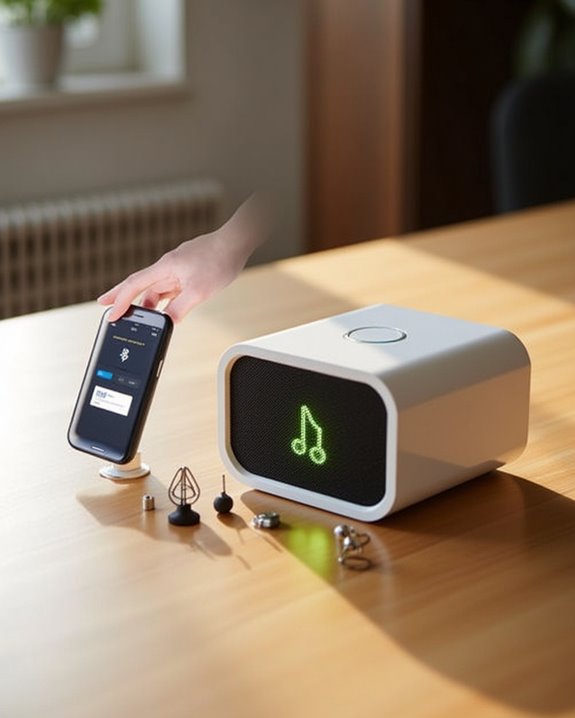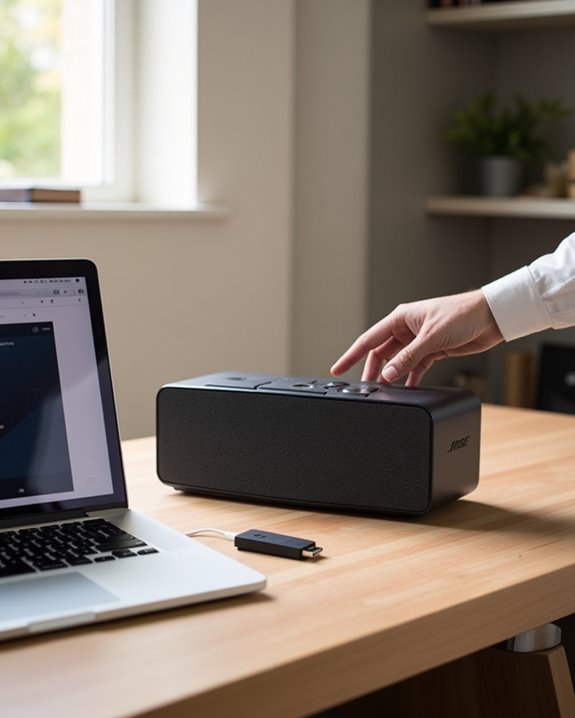Mobile devices connect to car speakers primarily via Bluetooth or wired interfaces. Bluetooth employs wireless IEEE 802.15.1 protocols, enabling audio streaming with minimal latency and pairing ranges up to 10 meters, while USB connections—using Type-C or Micro-USB cables—facilitate digital audio transmission and Android Auto integration for Android 6.0+ devices. Auxiliary cables (3.5mm jack) provide analog signals compatible with most vehicles’ AUX inputs, though signal interference may occur. Alternative FM transmitters broadcast audio over 87.7–107.9 MHz frequencies but risk channel interference. Additional techniques optimize compatibility and troubleshoot connectivity, enhancing in-car audio experiences through precise setup and integration protocols.
Key Takeaways
- Use Bluetooth to pair your phone with the car audio system by enabling Bluetooth on both and selecting the car stereo from your device’s connection list.
- Connect your phone’s headphone jack to the car’s auxiliary (AUX) input using a compatible 3.5mm aux cable for direct audio playback.
- Use a USB cable to connect your phone to the car’s USB port, enabling audio playback and Android Auto features on supported devices.
- For older vehicles, utilize a cassette adapter to play audio through the tape deck if no AUX or Bluetooth options exist.
- Troubleshoot connection issues by restarting devices, toggling Bluetooth, checking cables, and updating firmware on both phone and car stereo.
Benefits of Playing Music From Your Phone in the Car
What advantages does playing music from a mobile phone in a vehicle offer compared to traditional audio sources? Mobile phones provide access to extensive personal libraries and streaming services, allowing users to stream music with high audio fidelity via Bluetooth or USB connections. Integration with Android Auto (for Android 6.0+) enables synchronous navigation and audio playback, enhancing convenience without manual switching. Bluetooth pairing facilitates automatic connection during subsequent drives, reducing setup time. Compared to CDs or radio, this approach supports customizable playlists and on-demand content, improving personalization. The car’s audio system benefits from digital signal processing compatibility, which optimizes sound quality. Additionally, many Bluetooth car speaker models support extended Bluetooth range of up to 150 feet, ensuring consistent connectivity even when the device is slightly away from the vehicle. Overall, playing music from a phone offers superior flexibility, ease of use, and integration with vehicle infotainment systems, fulfilling the needs of drivers who prioritize seamless, high-quality entertainment during commutes or road trips.
Safety Tips When Using Your Phone While Driving
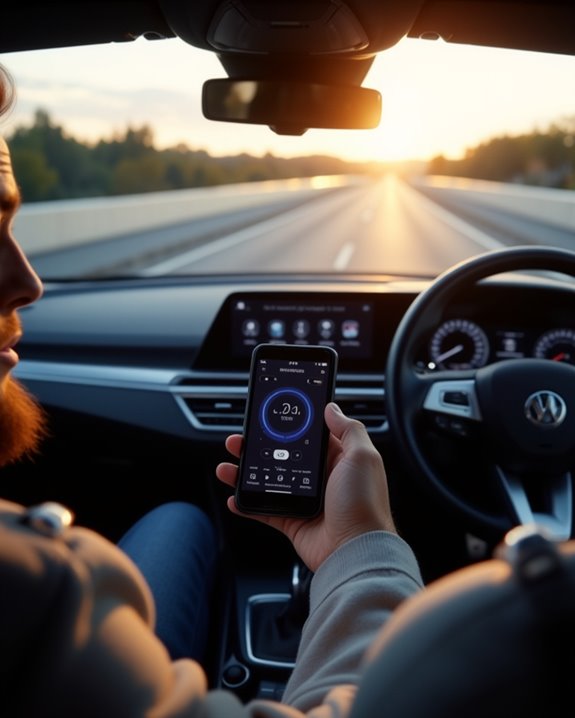
Effective management of mobile devices while driving requires minimizing manual interactions, as tactile distractions have been quantified to increase accident risk by up to 400%, according to the National Highway Traffic Safety Administration. Ensuring compliance with regional legal frameworks, including prohibitions on app-based streaming in certain jurisdictions, mandates reliance on hands-free technologies and in-vehicle control interfaces. These practices collectively enhance situational awareness and reaction times, thereby promoting safer driving conditions. Utilizing wireless Bluetooth speakers for cars with advanced features such as noise reduction and voice assistant compatibility can further reduce the need for manual device handling during drives.
Minimize Driver Distractions
Although mobile devices offer convenient access to audio and navigation features, interacting with them while driving greatly increases cognitive load and manual distraction, leading to elevated accident risk comparable to texting or phone calls. To minimize distractions, drivers should utilize Bluetooth connectivity paired with steering wheel controls, enabling hands-free adjustments to audio or navigation without diverting attention. Alternatively, passengers can operate devices to maintain driver focus. If interaction is necessary, pulling over in a safe, designated area is advised to avoid hazards. Switching to broadcast radio provides a distraction-free entertainment option by eliminating phone handling. These measures collectively reduce the likelihood of impaired reaction times and accidents. Adhering to such practices supports safer driving environments and aligns with prevailing safety recommendations to mitigate mobile phone-related risks on the road.
Legal Phone Usage Rules
Where regulations govern the use of mobile devices in vehicles, strict adherence to legal phone usage rules is paramount to guarantee road safety and compliance with traffic laws. Utilizing a mobile phone via bluetooth allows hands-free operation, greatly reducing manual distractions. Drivers should avoid physically interacting with their phones while driving, relying instead on steering wheel controls or passengers for audio adjustments. Pulling over before altering phone settings further mitigates risk by ensuring full attention to the road during transit. In many jurisdictions, phone use including calling or texting while driving is prohibited due to increased collision likelihood. As an alternative, broadcast radio provides continuous audio entertainment without requiring device interaction, enhancing safety. Following these guidelines promotes responsible mobile connectivity and adherence to legal standards, fostering safer driving environments.
Connecting Your Phone Using an Aux Cable
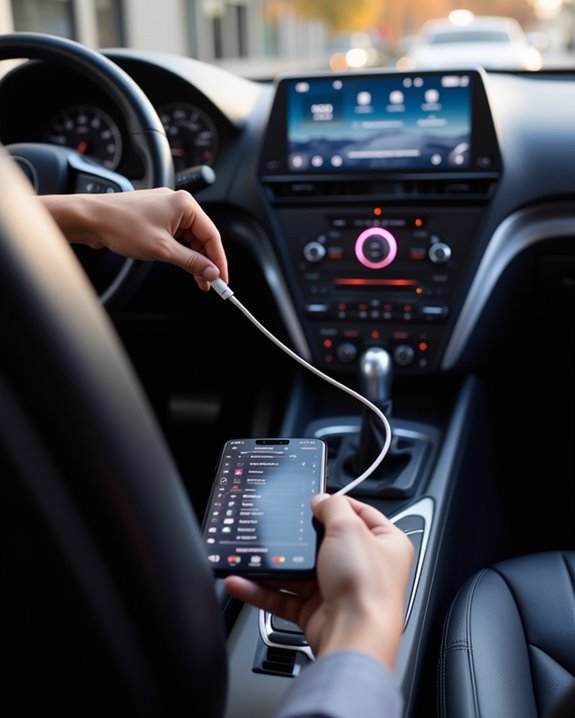
Connecting a mobile device to a car speaker via an aux cable requires inserting a 3.5mm jack into the phone’s headphone port and the vehicle’s auxiliary input, typically found on the audio system front panel, center console, or beneath the armrest. Compatibility with reliable models, such as the StarTech aux cable, guarantees consistent analog audio transmission, while older vehicles lacking aux ports may utilize a cassette adapter to interface through the tape deck. This method supports direct audio playback but necessitates manual control adjustments due to its analog nature and limited integration with digital vehicle systems. For optimal sound quality, selecting well-designed Portable Bluetooth Speakers with AUX support can enhance your listening experience even when wiring is involved.
Aux Cable Setup
An aux cable setup utilizes a 3.5mm stereo male-to-male connector to establish a direct analog audio link between a mobile device’s headphone output and a vehicle’s auxiliary input port, typically situated on the front panel of the infotainment system, within the center console, or beneath the armrest. To guarantee best performance, the aux cable must be securely connected to both the phone and the aux port, minimizing signal loss and audio interruptions. Users should test the connection by playing audio through their device’s music application. For vehicles lacking a dedicated aux port, cassette adapters provide a viable alternative, converting the 3.5mm output for tape decks. Selecting a high-quality aux cable, such as the StarTech model, reduces issues like poor sound fidelity and disconnections, while regular inspection counters wear-induced degradation common to analog connections.
Location of Aux Port
The auxiliary (aux) port, designed as a standard 3.5mm stereo jack, is strategically positioned within various accessible areas of a vehicle’s interior to facilitate seamless audio input from mobile devices. Common placements include the front panel of the car’s audio system, the center console adjacent to gear shifts or cup holders, and sometimes within the armrest compartment. These locations optimize user convenience by minimizing the need for extensive cable reach or awkward positioning. To guarantee compatibility, it is essential to verify that the port matches the phone’s headphone jack size—3.5mm—which supports direct analog audio transmission. Due to variability in make and model, consulting the vehicle’s owner manual is recommended to locate the exact aux port position, thereby enabling efficient connection and high-quality sound output through the car’s speakers.
Using Cassette Adapter
While many contemporary vehicles feature auxiliary input ports, older car stereos with cassette tape players require alternative methods for integrating mobile audio devices. A cassette adapter enables connection by inserting the adapter into the tape deck, with a 3.5mm aux cable linking the phone’s headphone jack to the adapter’s input. This analog interface mimics cassette signals, allowing audio playback through the car stereo’s speakers. Cassette adapters serve as economical solutions for vehicles lacking aux ports, though compatibility depends on the phone’s 3.5mm jack. Proper insertion guarantees stable signal transmission, minimizing playback interruptions. However, frequent use may accelerate wear on the tape mechanism, limiting longevity compared to digital connections. Evaluated for ease of use, signal fidelity, and durability, cassette adapters provide a practical, if technically limited, option for integrating mobile audio into legacy car stereo systems.
Pairing Your Phone via Bluetooth to Your Car Stereo
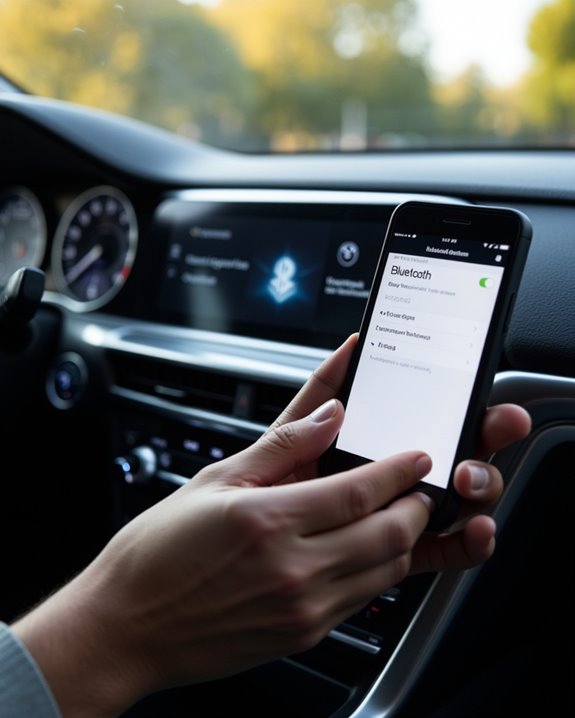
How does one initiate a reliable Bluetooth connection between a mobile device and a car stereo system? First, activate Bluetooth on the car audio system and set it to discoverable mode by following the car’s handbook instructions. On an Android Bluetooth device, navigate to Settings > Device Connection, then scan for available devices and select the car stereo to pair. Restarting the phone beforehand often increases pairing success by resolving initial connectivity issues. Once paired, the Bluetooth device automatically reconnects on subsequent drives, provided the phone maintains sufficient battery charge. If issues persist, toggling Bluetooth off and on, followed by reinitiating pairing via the car’s display settings, improves reliability. This method guarantees a stable wireless audio link, compatible with most modern car stereo systems, facilitating hands-free communication and high-quality audio streaming.
Using USB Cables to Link Your Phone With Your Car Audio
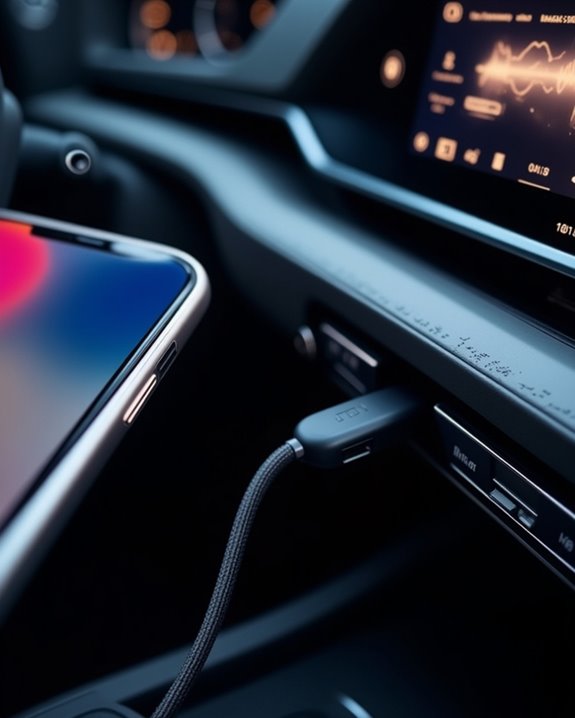
Connecting an Android phone to a car audio system via USB cable involves establishing a physical data link through the device’s USB port and the vehicle’s corresponding input, enabling direct audio playback and enhanced device integration. Using a USB cable, users connect their phone’s USB Type-C or Micro-USB port to the car’s USB input. Micro-USB cables support MP3 playback from internal storage but lack app streaming capabilities. USB Type-C cables offer data transfer rates up to 10 Gbps, potentially enabling streamed audio depending on device compatibility. For ideal performance, devices running Android 6.0 or higher benefit from Android Auto with a USB cable for app and navigation access. Troubleshooting includes ensuring the phone is unsecured, in storage mode, and restarting both devices to maintain a stable USB connection.
How to Use Android Auto for Seamless Integration

What advantages does Android Auto offer for integrating mobile devices with vehicular infotainment systems? Android Auto supports seamless synchronization between compatible Android devices (version 6.0 or higher) and car audio systems, initially via USB cable and, from Android 11 onward, through wireless connection in supported vehicles. Once paired, users can play music stored locally or streamed via apps, with audio routed through the car’s speakers for enhanced sound quality. The platform also integrates GPS navigation and voice command functionalities, allowing hands-free control and minimizing driver distraction. Setup involves enabling Android Auto in device settings and authorizing the car’s infotainment prompts. By facilitating direct control through steering wheel buttons or voice, Android Auto improves safety while delivering convenient access to multimedia, establishing it as a technically robust and user-centric mobile-to-car audio integration solution.
Troubleshooting Common Connection Issues
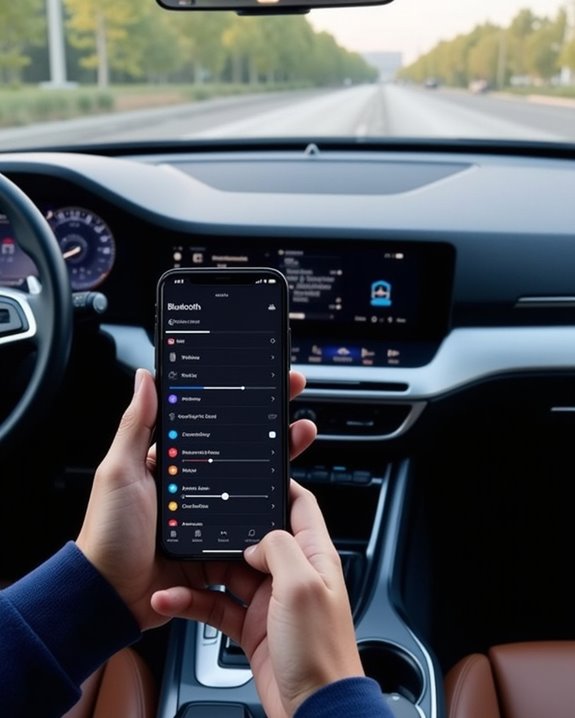
Despite the advanced integration capabilities offered by platforms such as Android Auto, users may encounter a range of connection issues that impair audio transmission between mobile devices and car speaker systems. Common problems include Bluetooth pairing failures, which often resolve by restarting devices, toggling Bluetooth settings, and consulting the vehicle’s manual for proper setup. USB port-related issues may present as no audio playback from applications like Spotify; testing alternative USB cables or ports and ensuring the device is active on the Home screen helps isolate hardware faults. Additionally, users should verify call routing settings when aux adapters transmit music but not calls, particularly with models like the iPhone 7. Persistent connectivity challenges benefit from forgetting paired devices, re-pairing, and updating firmware on both the mobile device and car stereo, ensuring ideal compatibility and performance.
Alternatives When Your Car Lacks Bluetooth or Aux Ports
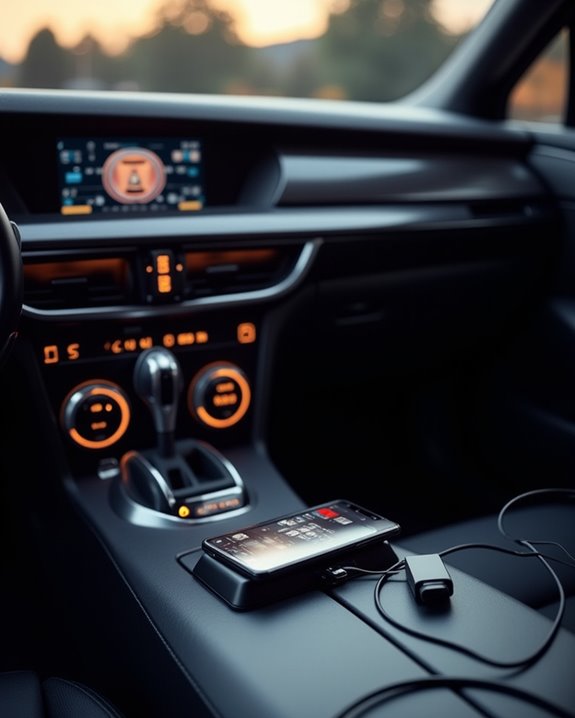
When a vehicle lacks integrated Bluetooth or auxiliary ports, several alternative audio interface options enable mobile device connectivity, each with distinct operational principles and performance characteristics. Users can connect using a cassette adapter compatible with standard tape decks, transmitting analog signals directly to the car’s audio system; this method supports continuous playback but may introduce minor static. Another option is to connect using a USB port with a Micro-USB cable, facilitating MP3 playback from stored files, although it typically does not support streaming applications. As a final alternative, an FM transmitter connects using the phone’s headphone jack, broadcasting audio over selectable FM frequencies (87.7–107.9 MHz), enabling wireless reception via the car’s radio. However, FM transmitters require precise tuning to minimize interference and may yield lower audio fidelity compared to direct digital connections.
Pros and Cons of FM Transmitters for Audio Playback
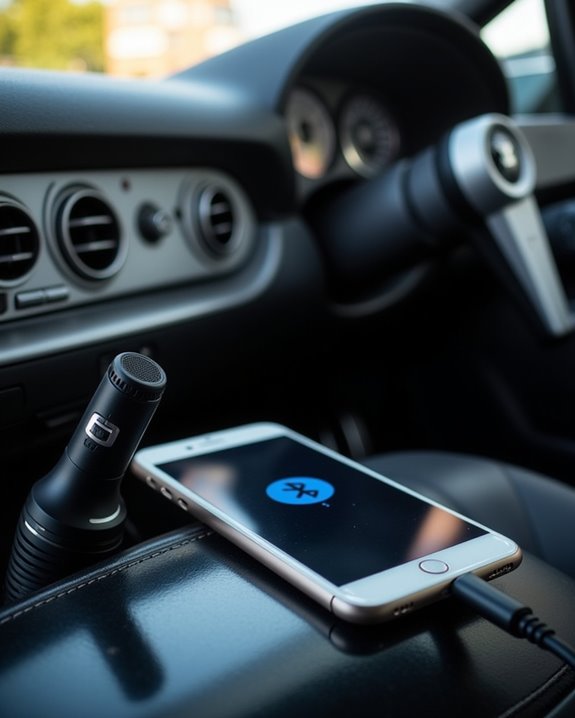
FM transmitters operate by broadcasting audio signals over specific FM radio frequencies, enabling mobile devices to connect to car speakers without direct wiring, which is advantageous for older vehicles lacking Bluetooth or auxiliary inputs. However, their susceptibility to frequency interference from local radio stations often results in inconsistent audio quality, and many transmitter apps demonstrate subpar reliability with security vulnerabilities including adware risks. Additionally, limited compatibility with modern smartphones and vehicle infotainment systems constrains their practical utility as a long-term audio playback solution.
FM Transmitter Advantages
An FM transmitter serves as a wireless intermediary device that broadcasts audio signals from a mobile device to a vehicle’s FM radio frequency, typically operating within the 88.1 to 107.9 MHz range, allowing audio playback without the need for physical connections such as auxiliary cables or Bluetooth pairing. This technology plays music seamlessly on older vehicles lacking Bluetooth or aux ports, offering a universal compatibility advantage. It operates by modulating the audio signal onto an FM carrier, which the vehicle’s radio receives within its standard frequency band. FM transmitters provide an accessible solution requiring minimal setup, facilitating quick connection and continuous playback. Their wireless nature eliminates cable clutter, enhancing convenience. Despite some performance variances, their ability to transmit across established FM bandwidths makes them a practical choice for integrating mobile audio with car speakers.
FM Transmitter Limitations
Despite the convenience and broad compatibility offered by FM transmitters for integrating mobile audio with vehicle sound systems, several limitations impact their overall effectiveness and reliability. FM transmitters frequently experience interference from local radio stations, causing degraded audio quality and inconsistent playback when playing music. This interference, combined with limited transmission range and dependence on clear FM frequencies, restricts their use, especially in urban environments. Additionally, many FM transmitter apps are plagued by adware, reflected in low user ratings due to intrusive advertisements and potential security issues. Hardware compatibility is often suboptimal, with frequent dropouts compared to wired or Bluetooth connections. While cost-effective and simple to set up, FM transmitters sacrifice sound fidelity and robust performance, making them a less reliable option for seamless mobile audio integration in modern vehicles.
Ensuring Compatibility Between Your Phone and Car System
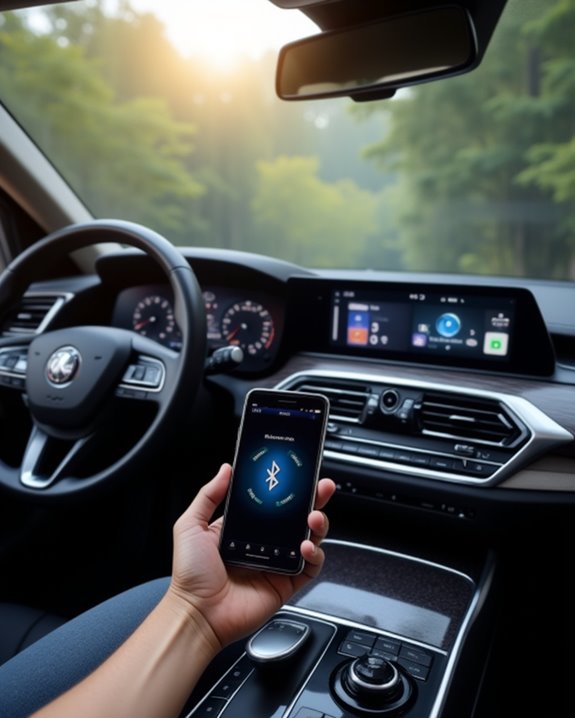
How can users guarantee seamless integration between their mobile devices and car audio systems? First, verify that the phone’s operating system supports the car’s interface: Android 6.0+ for Android Auto via USB cable and Android 11+ for wireless Android Auto achieve best functionality. Confirm the car stereo supports Bluetooth if wireless connection is desired, enabling pairing when both devices have Bluetooth enabled. Assess the phone’s charging port type—Micro-USB or USB Type-C—to match the car’s USB input, facilitating proper data transfer and audio streaming. Regular updates to the phone’s OS and car firmware are critical, resolving compatibility issues and enhancing performance. Reviewing the vehicle’s user manual for supported protocols and input specifications further guarantees reliable connectivity and maximizes the integration experience between mobile devices and car audio systems.
Frequently Asked Questions
How Do I Connect My Phone to My Car Speakers?
Connecting a phone to car speakers enhances audio quality, fostering shared experiences. Using Bluetooth or a 3.5mm aux cable, users join a community enjoying seamless music playback, strengthening bonds through personalized sound environments during drives.
Why Won’t My Phone Play Through My Car Speakers?
When the road’s soundtrack falls silent, speaker malfunction may be the hidden culprit. Phones struggle to harmonize with car systems due to Bluetooth glitches, outdated software, or connection chaos, leaving users yearning for seamless audio unity.
How Do I Pair My Phone to a Speaker?
Bluetooth pairing enables a phone to connect wirelessly to a speaker by activating Bluetooth on both devices, setting the speaker to pairing mode, and selecting the speaker from the phone’s available devices list, fostering seamless shared audio experiences.
How to Connect Phone to Car Bluetooth for Music?
Imagine Sarah enjoying crisp music quality on a road trip by pairing her phone to her car’s Bluetooth. Enabling Bluetooth on both devices guarantees seamless connection, fostering shared experiences and belonging through high-quality, wireless music playback.


